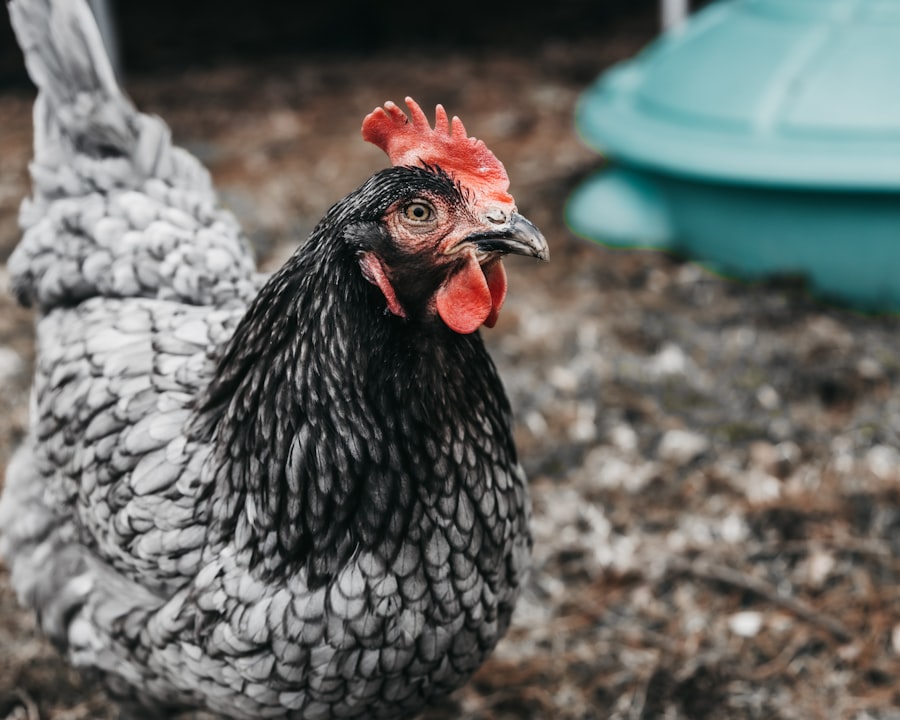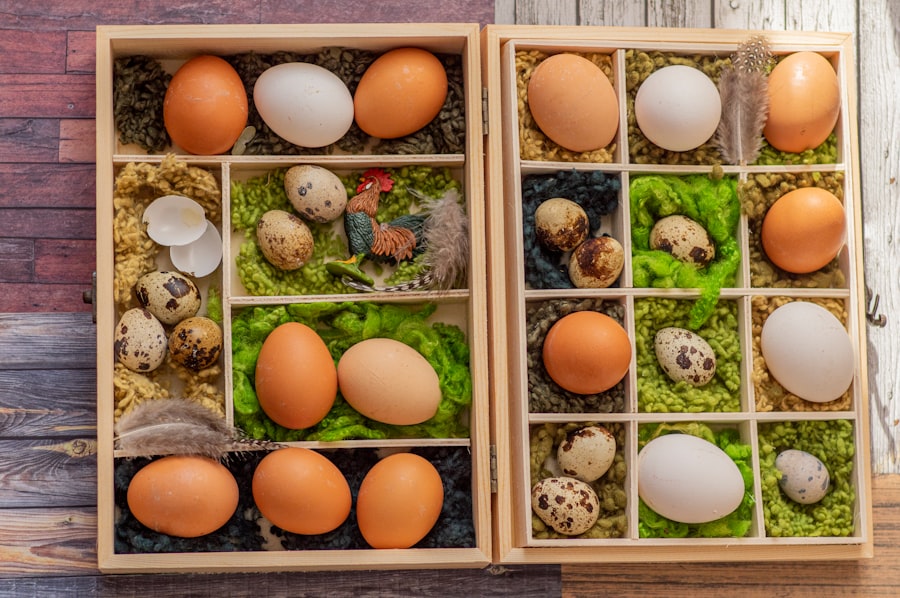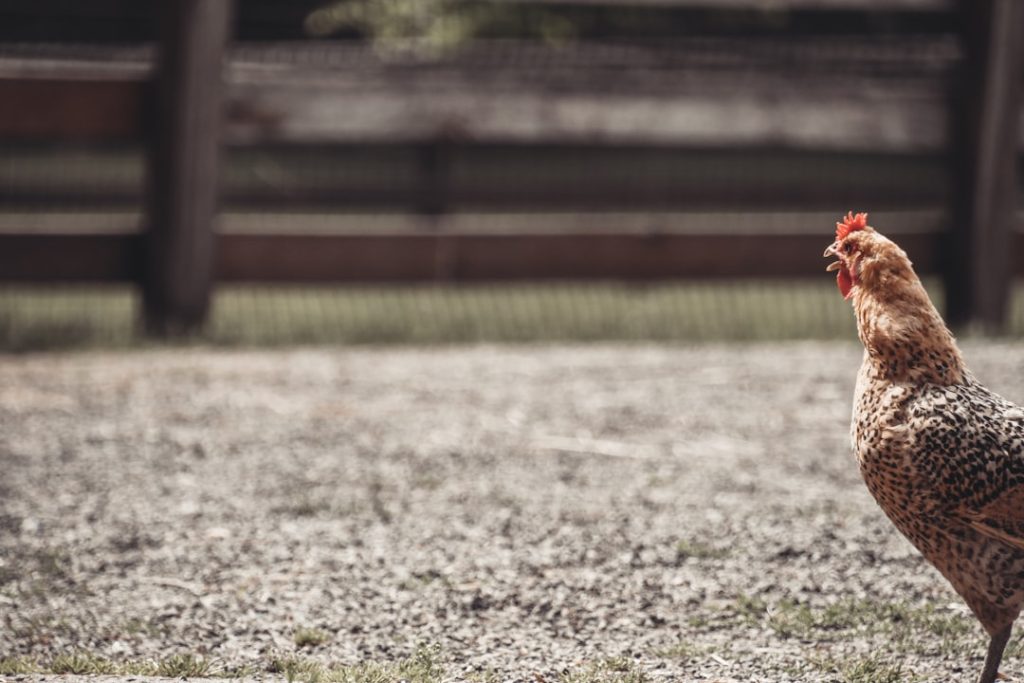Keeping chickens indoors has gained popularity among urban and suburban residents seeking the advantages of chicken-raising without the space requirements of outdoor coops. This practice enables a closer relationship with the birds and provides easy access to fresh eggs. However, it necessitates careful planning to ensure chicken welfare and maintain a clean living environment.
This article examines key aspects of indoor chicken keeping, including breed selection, coop and run setup, nutrition and hydration, cleanliness and hygiene practices, ventilation and lighting requirements, and addressing the birds’ behavioral and social needs. By understanding these factors, individuals can successfully raise chickens indoors while ensuring the health and happiness of their feathered companions.
Table of Contents
- 1 Selecting the Right Breed of Chickens for Indoor Living
- 2 Setting Up a Coop and Run Inside Your Home
- 3 Providing Proper Nutrition and Hydration for Indoor Chickens
- 4 Maintaining Cleanliness and Hygiene in the Indoor Chicken Environment
- 5 Ensuring Proper Ventilation and Lighting for Indoor Chickens
- 6 Addressing Behavioral and Social Needs of Indoor Chickens
- 7 FAQs
- 7.1 What are the benefits of keeping chickens indoors?
- 7.2 What are the key considerations for keeping chickens indoors?
- 7.3 What type of housing is suitable for indoor chickens?
- 7.4 What should be included in the indoor environment for chickens?
- 7.5 How can I maintain cleanliness when keeping chickens indoors?
- 7.6 What are some common challenges of keeping chickens indoors?
Key Takeaways
- Keeping chickens indoors can be a viable option for urban or small space dwellers
- Selecting the right breed of chickens for indoor living is crucial for their health and well-being
- Setting up a coop and run inside your home requires careful planning and consideration of space
- Providing proper nutrition and hydration is essential for the health of indoor chickens
- Maintaining cleanliness and hygiene in the indoor chicken environment is important for preventing diseases and ensuring their well-being
- Proper ventilation and lighting are necessary for the health and comfort of indoor chickens
- Addressing the behavioral and social needs of indoor chickens is important for their overall well-being and happiness
Selecting the Right Breed of Chickens for Indoor Living
Ideal Breeds for Indoor Living
Bantam breeds, such as Silkies and Seramas, are popular choices for indoor chicken keeping. These breeds are known for their small size and friendly disposition, making them a great fit for indoor environments. They are docile, easy to handle, and require less space, making them ideal for apartments or homes with limited space.
Key Considerations for Indoor Chicken Keeping
When selecting a breed for indoor living, it’s crucial to consider several factors. Noise level is a significant consideration, as some breeds can be quite loud. Egg production is another important factor, as some breeds are more prolific layers than others. Cold hardiness is also essential, especially if you live in an area with harsh winters.
Research and Choose Wisely
Ultimately, researching different breeds and choosing one that fits your specific needs and living situation is vital. By selecting a breed that is well-suited for indoor living, you can create a happy and healthy environment for both you and your chickens.
Setting Up a Coop and Run Inside Your Home

Setting up a coop and run inside your home requires careful planning to ensure the comfort and safety of your indoor chickens. The coop should provide enough space for the chickens to move around comfortably, as well as nesting boxes for laying eggs. It’s important to use materials that are easy to clean and sanitize, such as plastic or metal, to maintain a hygienic environment.
The run should allow for exercise and access to natural light, as well as provide opportunities for dust bathing and foraging. Consider using materials like straw or wood shavings for bedding, as they are absorbent and provide a comfortable surface for the chickens to walk on. Additionally, providing perches and enrichment activities, such as hanging treats or toys, can help keep indoor chickens mentally stimulated and physically active.
It’s also important to consider the placement of the coop and run within your home to minimize noise and odor, as well as to ensure proper ventilation and lighting.
Providing Proper Nutrition and Hydration for Indoor Chickens
Proper nutrition and hydration are essential for the health and well-being of indoor chickens. A balanced diet should include a high-quality commercial feed that is specifically formulated for laying hens, as well as access to fresh water at all times. Additionally, offering occasional treats such as fruits, vegetables, and mealworms can provide variety and enrichment for the chickens’ diet.
It’s important to monitor their food intake and adjust portion sizes as needed to prevent obesity or malnutrition. Providing access to grit is also important for indoor chickens, as it aids in digestion by helping them grind up their food in their gizzards. Additionally, offering calcium supplements or crushed oyster shells can help ensure strong eggshells for laying hens.
It’s important to monitor the chickens’ body condition and egg production to ensure they are receiving adequate nutrition.
Maintaining Cleanliness and Hygiene in the Indoor Chicken Environment
Maintaining cleanliness and hygiene in the indoor chicken environment is crucial for preventing disease and ensuring the well-being of the birds. Regular cleaning of the coop and run is essential to remove waste, soiled bedding, and food debris. This helps prevent the buildup of harmful bacteria and parasites that can affect the health of the chickens.
Using natural or non-toxic cleaning products can help maintain a safe environment for both the chickens and their caretakers. Additionally, implementing a regular cleaning schedule for feeders, waterers, and nesting boxes can help prevent contamination and maintain a healthy living space for the chickens. Proper waste management is also important, whether through composting or proper disposal methods, to minimize odor and pests in the indoor environment.
Ensuring Proper Ventilation and Lighting for Indoor Chickens

Ventilation: Removing Harmful Elements
Good ventilation helps remove excess moisture, ammonia, and airborne pathogens from the coop, which can lead to respiratory issues if left unchecked. This can be achieved through windows, vents, or fans that allow for air circulation without creating drafts that can cause temperature fluctuations.
Lighting: Regulating Circadian Rhythms
Providing natural or artificial lighting that mimics natural daylight can help regulate the chickens’ circadian rhythms and encourage healthy egg production.
Maintaining a Comfortable Environment
It’s important to monitor temperature and humidity levels within the indoor chicken environment to ensure they fall within a comfortable range for the birds.
Addressing the behavioral and social needs of indoor chickens is essential for their overall well-being. Chickens are social animals that thrive in flocks, so it’s important to provide opportunities for social interaction within the indoor environment. This can be achieved through providing multiple perches or roosting spots, as well as ensuring enough space for the chickens to move around comfortably.
Additionally, providing enrichment activities such as hanging treats or toys can help keep indoor chickens mentally stimulated and prevent boredom or stress-related behaviors. It’s also important to monitor their behavior for signs of aggression or bullying within the flock, as well as provide opportunities for dust bathing and foraging to satisfy their natural instincts. Creating a stimulating and enriching environment can help ensure the happiness and well-being of indoor chickens.
In conclusion, keeping chickens indoors can be a rewarding experience that allows for a closer bond with the birds and a convenient source of fresh eggs. However, it requires careful planning and consideration to ensure the well-being of the chickens and the cleanliness of the living space. By selecting the right breed, setting up a suitable coop and run, providing proper nutrition and hydration, maintaining cleanliness and hygiene, ensuring proper ventilation and lighting, and addressing behavioral and social needs, indoor chicken keepers can create a comfortable and enriching environment for their feathered friends.
If you’re considering keeping chickens indoors, you may also be interested in learning about the best kind of coop for chickens. Check out this article to find out more about the different types of coops available and which one may be best for your indoor chicken setup.
FAQs
What are the benefits of keeping chickens indoors?
Keeping chickens indoors can provide protection from predators, better control of temperature and lighting, and easier access for care and maintenance.
What are the key considerations for keeping chickens indoors?
Key considerations for keeping chickens indoors include providing adequate space, proper ventilation, access to natural light, and a suitable flooring material.
What type of housing is suitable for indoor chickens?
Suitable housing for indoor chickens includes a well-ventilated coop or cage with enough space for the chickens to move around, roost, and lay eggs.
What should be included in the indoor environment for chickens?
The indoor environment for chickens should include nesting boxes, perches, a dust bath area, and access to fresh water and a balanced diet.
How can I maintain cleanliness when keeping chickens indoors?
Maintaining cleanliness when keeping chickens indoors involves regular cleaning of the coop or cage, providing proper bedding material, and managing waste effectively.
What are some common challenges of keeping chickens indoors?
Common challenges of keeping chickens indoors include managing odors, preventing boredom and aggression, and ensuring proper socialization and exercise for the chickens.
Meet Walter, the feathered-friend fanatic of Florida! Nestled in the sunshine state, Walter struts through life with his feathered companions, clucking his way to happiness. With a coop that’s fancier than a five-star hotel, he’s the Don Juan of the chicken world. When he’s not teaching his hens to do the cha-cha, you’ll find him in a heated debate with his prized rooster, Sir Clucks-a-Lot. Walter’s poultry passion is no yolk; he’s the sunny-side-up guy you never knew you needed in your flock of friends!







